Design and Implementation of an Automated Medicinal-Pill Dispenser with Wireless and Cellular Connectivity
Volume 8, Issue 3, Page No 161-169, 2023
Author’s Name: Chanuka Bandara1, Yehan Kodithuwakku1, Ashan Sandanayake1, R. A. R. Wijesinghe2, Velmanickam Logeeshan3,a)
View Affiliations
1Department of Electrical, Electronic and Telecommunication Engineering, Faculty of Engineering, General Sir John Kotelawala Defence University, Sri Lanka
2Department of Mechanical Engineering, Faculty of Engineering, General Sir John Kotelawala Defence University, Sri Lanka
3Department of Electrical Engineering, University of Moratuwa, Sri Lanka
a)whom correspondence should be addressed. E-mail: logeeshanv@uom.lk
Adv. Sci. Technol. Eng. Syst. J. 8(3), 161-169 (2023); ![]() DOI: 10.25046/aj080318
DOI: 10.25046/aj080318
Keywords: Adherence, IoT, Dispenser, Web Interface, Pills, Regimen
Export Citations
Medical adherence is a major concern globally and is increasing with improved access to medication. Unfortunately, patients taking multiple medications often struggle with confusion about when and how to take each medication. To address this issue, an inexpensive domestic device has been proposed to improve medication adherence. This device uses Wi-Fi and cellular Internet of Things (IoT) integration to dispense medication at the prescribed times, making it suitable for use in both home and long-term care settings. The device also includes a web interface that allows users to control the device and make changes to dosage and other related information. Additionally, the device features an intricate system for sorting pills to ensure accurate and efficient medication delivery. Automating medication taking through this device can improve patient adherence and overall health outcomes, which could significantly impact public health and quality of life for patients struggling with medication adherence.
Received: 01 January 2023, Accepted: 23 February 2023, Published Online: 12 June 2023
1. Introduction
The purpose of this paper is to present a revised and expanded version of the smart medicinal pill dispenser originally presented at the World AI IoT Congress in 2022 [1]. Additional research and testing have been conducted to further improve the device and to provide more in-depth explanations of its functionality and effectiveness. This paper presents the updated findings and conclusions from the continued research, development and testing of the smart medicinal pill dispenser.
Medicine has evolved alongside humanity, with treatments and technologies constantly improving and advancing. While there are still a handful of currently incurable diseases, the vast majority of illnesses can be treated with some form of medication. Despite numerous medical advances, oral medication remains the most convenient and widely available form of treatment [2]. This is due, in part, to the fact that oral medication is easy to administer and does not require specialized equipment or training. As a result, oral medication continues to be a crucial aspect of modern healthcare.
The increasing use of oral medication highlights the importance of effective systems for managing and administering these drugs. In the United States, prescription drug usage in 2020 was 6.324 billion, significantly increasing from the 3.953 billion doses used in 2009 [3]. Globally, the IMS Institute for Healthcare Informatics estimates that 4.5 trillion doses of oral medication were used in 2020, a 24% increase over 2015 [4]. These statistics underscore the need for efficient and convenient systems for administering oral medication, particularly for patients taking multiple drugs or those in long-term care facilities. Effective management of oral medication can help improve patient adherence and overall health outcomes, making it a crucial aspect of modern healthcare.
Managing multiple medications can be challenging for patients, especially when multiple types of drugs are prescribed in a single prescription, as is common practice among doctors. This can be especially difficult for patients who are taking multiple medications or who have complex treatment regimens. A study conducted by Wolf et al. [5] found that a significant percentage of patients struggle with complex medication regimens. In fact, only about 15% of the target group in the study organized their dose times to create a more manageable routine. This can be particularly problematic for patients taking number of medications. A study by Garfinkel and Mangin [6] showed that the target group in their study used an average of 8 medications in a single prescription.
Adherence to medications is crucial in healthcare, particularly for those taking oral medications. The World Health Organization (WHO) has determined that if a patient’s adherence to medication is generally considered satisfactory if the proportion of prescribed medication taken as directed is greater than 80%. This is determined by calculating the number of pills absent in each time period and dividing it by the number of pills prescribed by the physician in that same time period [7].
Unfortunately, many patients struggle to consistently follow their prescribed treatment regimens, leading to significant problems with non-adherence. The WHO recognized this as a major health issue in 2003 [8], and subsequent studies have further highlighted the prevalence and consequences of non-adherence. For example, a study by Eindhoven et al. [9] found that only 40% of the general population consistently followed their prescribed medical routines. Another study conducted in Sri Lanka [10] revealed that a large majority (84.5%) of 303 patients with high blood pressure at the Teaching Hospital of Jaffna were non-adherent to their medication regimens. This was primarily due to forgetfulness and disruptions in daily routines, but other factors, such as managing multiple medications or feeling that they do not receive sufficient attention (particularly among elderly patients) can also contribute to non-adherence. The consequences of medical non-adherence can be severe, including increased risk of antibiotic resistance, worsening of existing conditions, and falling outside of the therapeutic range [11].
According to a study by Kheir et al. [12], over 15% of patients ignore the recommended dosages for over-the-counter (OTC) drugs. OTC medications are widely available and do not require a prescription, making them convenient for treating common ailments. Some common OTC medications include acetaminophen, antihistamines, and antacids [13]. However, the ease of access and lack of direct supervision by a healthcare provider can lead to issues with non-adherence to dosage recommendations. This can have negative consequences for patient health and well-being, as taking too much or too little of a medication can have dire consequences. As such, it is important for patients to follow dosage recommendations for OTC drugs carefully and to seek guidance from a healthcare provider if they have any questions or concerns.
Wolf M. et al. [14] found that accidental overdose on acetaminophen (also known as paracetamol) is a common problem with OTC medications. The same study states that over 23% of participants accidentally overdosed on acetaminophen products. This is often due to a lack of knowledge about proper dosage and dosing intervals for OTC medications and the fact that different medications have different recommended dosages and dosing intervals. For example, the recommended adult dosage for acetaminophen is two pills every 6 hours [15], while the recommended adult dosage for ibuprofen is 2 pills every 8 hours [16]. This suggests that while many people are aware of common OTC medications and their intended uses, they may not clearly understand proper dosage and dosing intervals. This lack of knowledge can increase the risk of accidental overdose and other adverse health consequences.
Inadequate adherence to medication regimens is a significant issue that contributes to negative health outcomes and increased healthcare costs. One of the major challenges in ensuring proper medication adherence is the complexity of some regimens, which can involve taking multiple medications at different times of day or administering drugs in unconventional ways. These factors can be confusing for patients and may lead to doses being missed or taken at the wrong times [17]. According to the Centers for Disease Control and Prevention (CDC), the United States experiences over 2.8 million antibiotic-resistant infections annually, and antibiotic resistance is responsible for over 35,000 deaths [18]. Improper medication use, including self-medication with antibiotics and not following dosage instructions, contributes to the growing problem of antibiotic resistance.
2. Analysis of Survey and Interview Data on Medicine Usage
2.1. Survey analysis
A survey was conducted among a sample of Sri Lankan adults over the age of 40 years to examine patterns of medicine used in this population in 2022. The survey sample was obtained through distribution to university students, resulting in a total of approximately 320 participants.

Figure 1: Proportion of long-term illnesses in the survey sample population
The survey results revealed a high prevalence of chronic diseases among Sri Lankan adults (Figure 1). In particular, it was found that over 95% of the target group had at least one chronic condition, with diabetes being the most common at over 40%. Additionally, the survey revealed that over 30% of Sri Lankan adults had high blood cholesterol or hypercholesterolemia. In addition to the high prevalence of diabetes and hypercholesterolemia among Sri Lankan adults, the survey also identified other common chronic conditions. Cardiac diseases, such as hypertension, were prevalent among a significant percentage of the target group. Additionally, a significant number of participants reported suffering from arthritis. Cancer was also reported among a small percentage of the sample. The findings of the 2022 survey are consistent with those obtained in a previous survey on the same topic in 2021 by Bandara C. et al. [1].

Figure 2: Proportion of sample population reporting medication non-adherence within a month
In addition to examining the prevalence of chronic diseases among the survey sample, the survey also assessed participants’ adherence to their medication regimens (Figure 2). The results showed that under 30% of the population consistently took their medication without missing doses or rarely lacking. All other participants reported frequently forgetting to take their medication. These findings suggest that medication adherence is a significant issue among the Sri Lankan adult population, with the majority of participants struggling to consistently follow their prescribed treatment regimens.
2.2. Interview findings
A series of interviews were conducted with professionals in the medical sector to explore the issue of medication adherence. The interviews confirmed that patients are often prescribed multiple medications to treat their underlying diseases, manage symptoms, and control pain. It was noted that similar drugs are often included in the same regimen, which can lead to confusion for some patients. The professionals interviewed emphasized the importance of clear communication between healthcare providers and patients to ensure that patients fully understand their prescribed treatment regimens and the potential risks and benefits of each medication.
One potential source of confusion and non-adherence among patients taking multiple medications is the similarity in the appearance of certain drugs. For example, diabetes medications such as Metformin and Gliclazide may be easily mistaken for one another, particularly if they are taken at different frequencies (e.g., Metformin once daily and Gliclazide twice daily). Similarly, hypertension medications like Hydrochlorothiazide and Losartan Potassium, which may be taken at different frequencies (e.g., Hydrochlorothiazide twice daily and Losartan Potassium once daily), may also be confusing for some patients.
The interviews also revealed that patients may neglect their medication dosages due to busy schedules and may simply ignore their medication altogether. Additionally, older patients may not receive sufficient care to remind and administer their medication at home. These findings suggest that time constraints and lack of support may contribute to non-adherence among certain patient populations.
Although medical professionals are actively working to minimize the issue of non-adherence to medication regimens, the lack of resources and lack of patient cooperation are significant challenges. Despite efforts to educate patients about the importance of adherence and to provide support to help patients follow their prescribed treatment regimens, many patients continue to struggle with non-adherence.
3. Existing Approaches
3.1. The traditional approach to managing multiple medications.
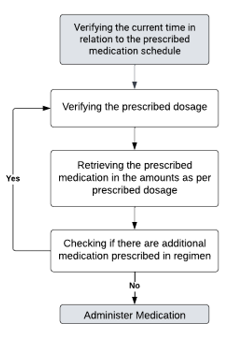
Figure 3: Flowchart of managing multiple medication by hand.
The traditional method of accessing and administering prescribed medications (Figure 3) typically involves manually checking the prescription and individually taking each type of medication in the prescribed dosage. This process can be tedious and time-consuming, and it can also lead to errors. For example, if the patient becomes distracted or fatigued while following their medication regimen, they may accidentally skip a dose or take an incorrect dosage. Additionally, if the patient has multiple medications with different dosing instructions, it can be easy to confuse or mix up the instructions, leading to further errors in medication adherence. This can have serious consequences for the patient’s health, as incorrect dosages or missed doses can lead to ineffective treatment or negative side effects.
3.2. Prevailing products
To address these challenges, a number of products have been developed and are currently available on the market where each of these products has its own limitations and challenges. Some major examples include, Pointells Automatic Pill Dispenser, Hero Medication Manager, e-Pill Voice Pro, MedaCube, and RxPense.
The Pointells Automatic Pill Dispenser requires users to manually sort and store each dose in a separate compartment, which can be time-consuming and inconvenient [19]. The Hero Medication Manager offers a user-friendly interface but is only available in certain regions and requires a subscription fee in addition to its high cost [20]. The e-Pill Voice Pro has many features, but also shares the limitations of the Pointells Automatic Pill Dispenser and includes an alarm feature that may disrupt users’ daily routines [21]. The MedaCube is a highly advanced medication dispenser but is expensive and not widely available [22]. The RxPense is a more compact alternative to the MedaCube, but also has a subscription-based payment model and limited global availability [23].
3.3. Comparable prototypes
The automated pill dispensing device by Ramkumar et al. [24] proposes a solution to the problem of medication non-adherence in patients using an automated pill dispenser that is connected to the Internet of Things (IoT). The proposed solution leverages the IoT to provide patients with medication reminders, dispense the right pills at the right time, and enable healthcare professionals to monitor their patients’ medication adherence in real-time. However, the device by Ramkumar et al. lack the ability to provide connectivity when the Wi-Fi connectivity is absent.
Karthikeyen et al. [25] proposes an autonomous bot to administer medication to elderly patients. The bot uses line-following mechanism to track the patient’s location and dispenses the required medicines based on user-programmed instructions. The system store information in the cloud for future reference. However, the device does not present a mechanism for the sorting and dispensing of pills in accordance with a predetermined schedule. Rather, its function lies in the delivery of medication to the patient and dispensing the pre-sorted pills as required.
The smart automated pill dispenser by Kumar [26] proposes a Wi-Fi enabled device with a smart app and a pill dispensing mechanism to address medication non-adherence. The device uses four separate cartridges for different sized pills. Which could limit the usability of the device.
To overcome the limitations of the implementations, it is suggested that a Global System for Mobile Communications (GSM) module be integrated into the system, a mechanism for automated sorting of medication without manual pre-sorting should be proposed, and the design of cartridges must also be optimized to accommodate pills of varying sizes and function seamlessly with the proposed sorting mechanism.
4. Proposed Device
The proposed device is designed to dispense medication at the prescribed times and remind the patient or guardian to administer the medication. This device conveniently stores the medications and manages the dosage, eliminating the need for the patient or guardian to worry about finding and correctly dosing the medications. With this device, users simply need to take the medication at the prescribed times, with the device managing all other aspects of the medication regimen. This feature allows for increased convenience and ease of use for the patient or guardian.
The proposed device is designed with several key components, including an ESP32 microcontroller, infrared sensors, a GSM module, a real-time clock module, and motors and motor drivers. These components work together to ensure that the device can dispense medication accurately at the prescribed times and provide reminders to patients or guardians as needed. Advanced technologies such as the ESP32 microcontroller and GSM module allow for integration with the IoT, enabling control of the device through a web interface. The inclusion of infrared sensors and a real-time clock module allow for precise timing and accuracy in the dispensing process. The motors and motor drivers ensure that the device is able to dispense the required medication doses efficiently. Overall, these components are essential for the effective functioning and performance of the proposed device.
4.1. Operation
The proposed device is designed to ensure that patients are able to take their medication on schedule and avoid missing doses (Figure 4). To accomplish this, the device uses a real-time clock module to track the current time and a GSM module to send reminders to the patient if they are behind schedule for their medication. Additionally, the device is equipped with infrared sensors and motors to dispense the appropriate dosage of medication based on the prescribed schedule. If the patient has not taken their previous dose, the device will not dispense the next one, but will instead send a reminder and reset its status so that the next dosage can be issued at the appropriate time.

Figure 4: Operation diagram of the proposed device
4.2. Physical design
The proposed device includes several compartments designed to dispense a specific medication. The design of these compartments includes a handle, an arm, a funnel, an infrared sensor space, a pill exit, and a disk (Figure 5).
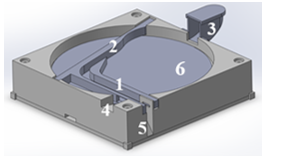
Figure 5: 3D model of a compartment. 1. Handle 2. Arm 3. Funnel 4. IR sensor space 5. Pill exit 6. Disk
The proposed device is designed to dispense medication using a rotating disk and an arm mechanism. Medication is inserted into the device through a funnel, and then the disk rotates to separate a single pill. The pill is then passed through a gap between the arm and handle, and an infrared sensor detects its movement and signals the microcontroller to stop the rotation and dispense the pill. The motor used to rotate the disk is located within the compartment and attached to the disk. An additional infrared sensor is included to detect when the cup, which holds the dispensed medication, has been moved by the user, indicating that the medication has been taken.
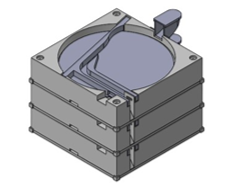
Figure 6: Compartments stacked
The proposed device includes individual compartments for each type of medication, with each compartment being approximately 15 cm by 15 cm in size. This allows for proper storage and organization of medications, ensuring that patients or caregivers can easily access the correct medication at the appropriate time. Multiple compartments can be stacked on top of each other for efficient storage and organization of multiple medications (Figure 6). The device also includes motors and infrared sensors to facilitate the dispensing process and track medication intake.
4.3. Working mechanism
The proposed device utilizes a rotating disc mechanism to dispense individual pills. The rotational speed of the disc is calculated to ensure that only a single pill is dispensed at a time. This is achieved by considering the relationship between angular velocity and linear velocity. The linear velocity of a rotating disc increases as it moves further away from the center, and by carefully controlling the angular velocity, the device is able to accurately dispense single pills. This mechanism allows for the device to effectively dispense a wide range of pill sizes and shapes.
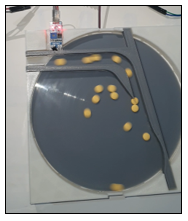
Figure 7: Extracting a single pill
Figure 7 illustrates a momentary snapshot of the rotation of the disk in an open compartment unit. Pills closer to the center of the disc experience a lower linear velocity, while those further from the center experience a higher linear velocity. This can be observed in the differential blur of pills in the center versus those at the edges of the disc in Figure 7. This method allows for efficient and accurate dispensing of medication.
The pill separation is achieved by first rotating the disk in a backward direction (clockwise in Figure 7) at varying speeds to disperse the pills across the surface of the disk. The disk is also rapidly oscillated back and forth to further spread out the pills. After this initial shaking process, the disk is then rotated in the forward direction through the path between the arm and handle of the device. As the pills are guided through this path, the linear velocity helps to create a gap between each pill. This method allows for the efficient separation of individual pills for accurate and reliable dispensing.
To optimize the dispensing process, the proposed device includes a dynamic adjustment feature for the rotation time and speed of the disk. This allows for the proper isolation of individual pills and ensures that they are dispensed accurately. The user can also manually reset and calibrate the rotation time using the provided controls. If a pill is not dispensed after two attempts, the rotation time and speed is adjusted, and the process is repeated. The updated rotation time and speed are then recorded in the microcontroller for future use.
It is important to consider the potential for damaging medication when spinning pills at high speeds. While high speeds may be effective in isolating individual pills, they may also cause pills to break or crumble. This can result in reduced efficacy of the medication or even potential harm to the patient if they ingest broken or damaged pills. It is essential to carefully consider the appropriate speed range for spinning pills in order to minimize the risk of damage while still effectively isolating individual doses. Additionally, the material and construction of the spinning mechanism should be carefully considered to ensure that it is strong enough to handle the forces involved without causing damage to the pills.
4.4. IoT implementation
A cellular IoT module was implemented to provide reminders to users via short message service (SMS). This allows users to be reminded of their medication schedule even when they are not at home, simply by using their mobile device. For example, if a user’s medication time is set for 8 pm, they will receive an SMS at 8.30 pm reminding them that they are half an hour past their medication time and encouraging them to take their medication as soon as possible. The delay in sending reminders for medication is intended to provide patients with a grace period to self-administer medication, if they recall it, without being prompted unnecessarily. This approach is aimed at minimizing the potential inconvenience. This implementation in overall adds convenience for users without the need for additional equipment.
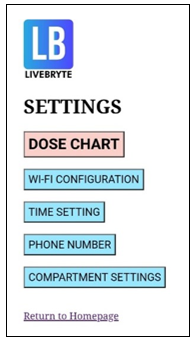
Figure 8: Settings page of the web-interface
The inclusion of the ESP32 microcontroller offers numerous benefits, including its lightweight design and 4 MB of SPI flash memory for permanent data storage [27]. The ESP32 microcontroller and Wi-Fi IoT capabilities to enable access to device configurations through an HTML and CSS based web interface (Figure 8). This interface can be accessed through a local Wi-Fi network or through the microcontroller’s own soft access point.
The web interface for the proposed device allows users to easily enter and modify their medication prescription information, including dosage and timing. This interface also allows users to customize device settings such as the device time, phone number for reminder messages, and Wi-Fi network to which the device is connected. By leveraging the IoT through the use of the ESP32 microcontroller, this interface can be accessed remotely, providing users with greater convenience and flexibility. It is important to note that utilizing an internet-connected network is recommended to enhance the user experience. Additionally, this web interface can be easily updated by linking additional information through URLs, allowing developers to easily make changes to the device without the need for hardcoding data directly into the device.
The proposed device includes a microprocessor with the capability to record and notify the user of any errors that may occur during device operation. This feature is implemented through the ESP32 microcontroller and its ability to store data in flash memory, even during a power interruption. This ensures that the device remains functional and able to provide necessary medication to the user. [28]
4.5. User operation
To initiate the operation of the device, To use the device for the first time, the user must access the device’s own soft access point (AP) address using the provided instructions. Then, they should enter the Service Set Identifier (SSID) and password for their current local network into the device. This will allow the device to connect to the local network and be accessible for further configuration and use.
Afterwards, the patient or guardian must first the user must load the appropriate medications into compartments using the provided funnel and input relevant information, such as the type of medication pills being stored in each container and their prescribed dosages using the “Dose Chart” page in the web-interface settings page shown in Figure 8. The “calibrate” feature should then be run using the “Compartment Settings” page, during which the device will dispense a single pill from each container to determine the optimal settings, including time and rotation speed, for the specific type of pill. The user may also need to adjust the timing and provide a phone number for alert notifications.
In the event of an error, whether due to missed medication or a technical malfunction of the device, the device ceases operation and alerts the user via SMS. The guardian or nurse must then confirm that the issue has been resolved and instruct the device to resume operation. This helps to ensure that any errors or disruptions in the medication regimen are promptly addressed and corrected.
Each dose must be double-checked before administration due to the sensitivity of the device’s operation.
5. Final Device Design
The completed product, named “LIVEBRYTE,” was made primarily of wood, with 3D printed parts made of polylactic acid (PLA).
5.1. Accuracy
There are several limitations to the current design of the proposed device. The device is currently limited to pills. Another limitation is the reliance on infrared sensors to detect pills as they are dispensed. This can be problematic as some pills may not be properly detected, as pills are passing the sensor at high velocities leading to inaccurate dispensing. In addition, the device is not able to handle pills that are particularly large or oddly shaped, as they may not pass through the dispensing path correctly. The device is also limited in its ability to handle many medications, as it can only store a limited number of pills in each compartment. Finally, the device relies on the user to accurately input information about the medications and their prescribed dosages, which can lead to errors if the user is not careful or if there are changes to the prescription. Despite these limitations, the device has shown significant improvement in accuracy during the troubleshooting phase, increasing from 40% to its current level through algorithmic improvements.
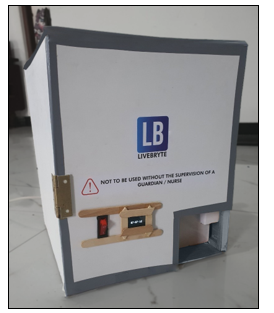
Figure 9: The final product
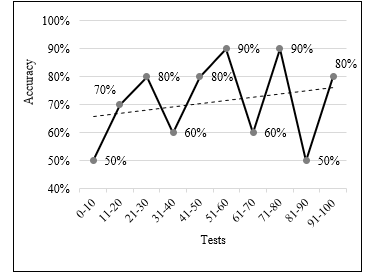
Figure 10: Accuracy for 100 tests
The accuracy of the LIVEBRYTE device was evaluated through a series of tests in which the device was instructed to dispense a single pill. First, the number of successful dispenses, defined as instances in which only a single pill was released, was recorded, and compared to the total number of dispense attempts. Next, unsuccessful dispenses, defined as instances in which no pills or more than one pill were released, were also recorded. The device’s accuracy was then calculated as the percentage of successful dispenses out of the total number of dispense attempts. This indicated the reliability and precision of the device in accurately fulfilling prescribed dosage regimens.
The results of these tests, conducted 100 times with an average accuracy of 71%, are depicted in Figure 10. The trendline illustrates that the accuracy of the device improved dynamically with dynamic adjustments.
The use of an infrared sensor as a proximity sensor ensures that the accuracy of the device is not affected by the color of the medication. However, it has been observed that pills with a glossy outer coating tend to be less responsive to the infrared sensor. Despite this, it can be ensured that there will not be any confusion between different medications, as each medication is stored in a separate compartment.
5.2. User feedback
The final product was provided to 10 long-term patients with varying levels of proficiency in using technology for a period of 10 weeks, or approximately 2.5 months. The patients were instructed to carefully review their medication doses and prescriptions before taking their medications, and the device was used to dispense and track their medication adherence. A survey was conducted at the end of the trial to gather feedback on the patients’ experiences with the device.
The results of the survey indicated that the majority of the participants were satisfied with the LIVEBRYTE device and believed that it aided in their medication adherence. On a scale of 1 to 5, the majority of participants rated the product as 4 out of 5. They reported that the device improved their medical adherence and that they experienced few errors during the week-long trial period. On average, participants experienced errors 6.09 times per week. This is consistent with the expectations for the device, given that the device was expected to produce 7.1 errors in average.
6. Conclusion
The proposed device is a smart pill dispenser designed to help patients and their caregivers manage and adhere to their prescribed medication regimens. The device stores multiple medications and dispenses them at the prescribed times, providing a convenient and reliable solution for those who struggle with medication management. In addition to dispensing medication, the device also sends reminders to the patient or caregiver to take their medication as prescribed. This can be especially helpful for those who take multiple medications and may have difficulty remembering which medications to take and when. The device is also equipped with a web interface that allows users to easily access and control the device, making it suitable for use in both home and long-term care settings. Overall, the automation of medication taking through this device has the potential to improve patient adherence and overall health outcomes, which could have a significant impact on public health and quality of life for patients struggling with medication adherence.
To further assess the usability and effectiveness of the device, it was given to 10 long-term patients for a period of 10 weeks (about 2 and a half months). These participants were instructed to always double-check their medication doses and their prescription before taking their medications. The results of a survey conducted after this trial period showed that most participants were satisfied with the product, with most rating it 4 out of 5. They reported that the device had helped with their medication adherence and that they had experienced few errors, with an average expected error rate of 6 per participant.
Despite the efforts made to improve accuracy, it is important to note that the proposed device is not intended to replace the role of a nurse or guardian in ensuring that patients take their medication as prescribed. The device is simply intended to assist in the process of medication adherence and should be used in conjunction with supervision to ensure the safe and effective administration of medication. It is also important to note that the device is not foolproof and may still be subject to errors or malfunctions. Therefore, it is essential that patients and guardians continue to carefully monitor their medication use and seek medical advice if any concerns arise.
It is important to consider the ethical implications of using this device. One potential concern is the potential for patients to rely too heavily on the device and neglect their own responsibility to manage their medication. It is essential that patients are educated on the importance of self-management and encouraged to take an active role in their own healthcare. Additionally, it is important to ensure that the device is used in accordance with the patient’s prescription and that any changes to the dosage or medication schedule are made in consultation with a healthcare provider.
Overall, the proposed device has the potential to significantly improve medication adherence and overall health outcomes for long-term patients. As outlined above, the device has successfully addressed the limitations of the compared devices and has incorporated additional features, thus enhancing its overall functionality.
There are several potential future improvements that could be made to the device to make it even more effective at improving medication adherence and overall patient health outcomes. One potential improvement could be to integrate more advanced sensors, such as weight sensors, to track medication usage and detect any potential issues with pill dispensing more accurately. Moreover, improvements for the physical compartment designs can be done to elevate the device efficiency and to accommodate a wider range of medications. The device could be developed to accommodate medication for multiple patients, providing the device much more capable in long-term care facility administrators. Additionally, incorporating machine learning algorithms into the device’s software could allow it to better adapt to individual patient needs and preferences, as well as optimize the timing and frequency of medication reminders based on user data. Other potential improvements could include integrating more advanced communication capabilities, such as voice recognition and virtual assistant functionality, to make the device more user-friendly and accessible for patients with limited technology skills. Finally, incorporating more robust data storage and analysis capabilities could allow the device to track patient medication usage and provide insights to healthcare providers on how to optimize treatment plans more effectively. Furthermore, implementing automatic refill reminders could help to ensure that patients never run out of their medication, while the ability to track and record medication intake could provide valuable information for healthcare professionals to use in managing their patients’ treatment. Additionally, integrating the device with healthcare systems could facilitate better communication and collaboration between patients and healthcare professionals. To ensure that patients are able to effectively use and benefit from the device, developing user-friendly interfaces and providing instructional materials could be helpful. Finally, it is important to conduct further testing and evaluation of the device to understand its potential impact and ensure that it is being used safely and appropriately.
- C. Bandara, A.D. Sandanayake, Y. Kodithuwakku, V. Logeeshan, “Automated Medicinal-Pill Dispenser with Cellular and Wi-Fi IoT Integration,” in 2022 IEEE World AI IoT Congress (AIIoT), IEEE: 692–698, 2022, doi:10.1109/AIIoT54504.2022.9817226.
- M.S. Alqahtani, M. Kazi, M.A. Alsenaidy, M.Z. Ahmad, “Advances in Oral Drug Delivery,” Frontiers in Pharmacology, 12, 62, 2021, doi:10.3389/FPHAR.2021.618411/BIBTEX.
- Medicines Use and Spending in the U.S, 2017.
- Global Medicines Use in 2020, Mar. 2022.
- M.S. Wolf, L.M. Curtis, K. Waite, S.C. Bailey, L.A. Hedlund, T.C. Davis, W.H. Shrank, R.M. Parker, A.J.J. Wood, “Helping Patients Simplify and Safely Use Complex Prescription Regimens,” Archives of Internal Medicine, 171(4), 300–305, 2011, doi:10.1001/ARCHINTERNMED.2011.39.
- D. Garfinkel, D. Mangin, “Feasibility Study of a Systematic Approach for Discontinuation of Multiple Medications in Older Adults,” Archives of Internal Medicine, 170(18), 2010, doi:10.1001/archinternmed.2010.355.
- M.T. Brown, J.K. Bussell, “Medication Adherence: WHO Cares?,” Mayo Clinic Proceedings, 86(4), 304–314, 2011, doi:10.4065/mcp.2010.0575.
- S. de Geest, E. Sabaté, “Adherence to long-term therapies: evidence for action,” European Journal of Cardiovascular Nursing : Journal of the Working Group on Cardiovascular Nursing of the European Society of Cardiology, 2(4), 323, 2003, doi:10.1016/S1474-5151(03)00091-4.
- D. lle C. Eindhoven, A.D. Hilt, T.C. Zwaan, M.J. Schalij, C.J.W. Borleffs, “Age and gender differences in medical adherence after myocardial infarction: Women do not receive optimal treatment The Netherlands claims database,” European Journal of Preventive Cardiology, 25(2), 181–189, 2017, doi:10.1177/2047487317744363.
- S. Pirasath, T. Kumanan, M. Guruparan, “A Study on Knowledge, Awareness, and Medication Adherence in Patients with Hypertension from a Tertiary Care Centre from Northern Sri Lanka,” International Journal of Hypertension, 2017, 2017, doi:10.1155/2017/9656450.
- A.F. Yap, T. Thirumoorthy, Y.H. Kwan, “Medication adherence in the elderly,” Journal of Clinical Gerontology and Geriatrics, 7(2), 64–67, 2016, doi:10.1016/J.JCGG.2015.05.001.
- N. Kheir, M.S. el Hajj, K. Wilbur, R.M.L. Kaissi, A. Yousif, “An exploratory study on medications in Qatar homes,” Drug, Healthcare and Patient Safety, 3(1), 99, 2011, doi:10.2147/DHPS.S25372.
- M.S. Rsfa, J.A.C. Perera, P.P.R. Perera, The usage of over the counter (OTC) medicines and traditional medicines (TMs) for common ailments in selected urban and rural areas in Sri Lanka, 2015.
- M.S. Wolf, J. King, K. Jacobson, L. di Francesco, S.C. Bailey, R. Mullen, D. McCarthy, M. Serper, T.C. Davis, R.M. Parker, “Risk of Unintentional Overdose with Non-Prescription Acetaminophen Products,” Journal of General Internal Medicine, 27(12), 1587, 2012, doi:10.1007/S11606-012-2096-3.
- Adult Acetaminophen Dosage Chart | GET RELIEF RESPONSIBLY®, Apr. 2022.
- Ibuprofen Dosing Table for Fever and Pain – HealthyChildren.org, Apr. 2022.
- B. Jimmy, J. Jose, “Patient Medication Adherence: Measures in Daily Practice,” Oman Medical Journal, 26(3), 155–159, 2011, doi:10.5001/omj.2011.38.
- Centers for Disease Control and Prevention, Antibiotic resistance threats in the United States, 2019, Atlanta, Georgia, 2019, doi:10.15620/cdc:82532.
- Amazon.com: Pointells Automatic Pill Dispenser – 28-Day Portable Medication Planner and Organizer – Dispense Vitamins and Tablets Up 6 Times Per Day – Includes Flashing Light, Alarm and Safety Lock : Health & Household, Apr. 2022.
- Hero Health – A dose of calm for the whole family, Apr. 2022.
- Voice Pro, Apr. 2022.
- PharmAdva MedaCubeTM, Apr. 2022.
- Medipense » RxPense the best pill dispenser for seniors, chronic care, +, Apr. 2022.
- J. Ramkumar, C. Karthikeyan, E. Vamsidhar, K.N. Dattatraya, Automated Pill Dispenser Application Based on IoT for Patient Medication, 231–253, 2020, doi:10.1007/978-3-030-42934-8_13.
- K.R. Karthikeyan, E. Dharan Babu, S. Ranjith, S. Arunkumar, “Smart Pill Dispenser for Aged Patients,” in 2021 International Conference on Advancements in Electrical, Electronics, Communication, Computing and Automation (ICAECA), IEEE: 1–5, 2021, doi:10.1109/ICAECA52838.2021.9675784.
- R.H. Kumar, Design and Prototype of Smart Automated Pill Dispenser, VISVESVARAYA TECHNOLOGICAL UNIVERSITY, 2021.
- ESP32¬WROOM¬32, 2022.
- N. Koumaris, Using ESP32’s Flash Memory for data storage – Electronics-Lab.com, Apr. 2022.
Citations by Dimensions
Citations by PlumX
Google Scholar
Crossref Citations
- Pallavi Tiwari, Ramakrishnan Raman, "Smart Pill Dispensers and IoT: Advancements in Medication Administration." In 2024 International Conference on Emerging Systems and Intelligent Computing (ESIC), pp. 484, 2024.
No. of Downloads Per Month
No. of Downloads Per Country
